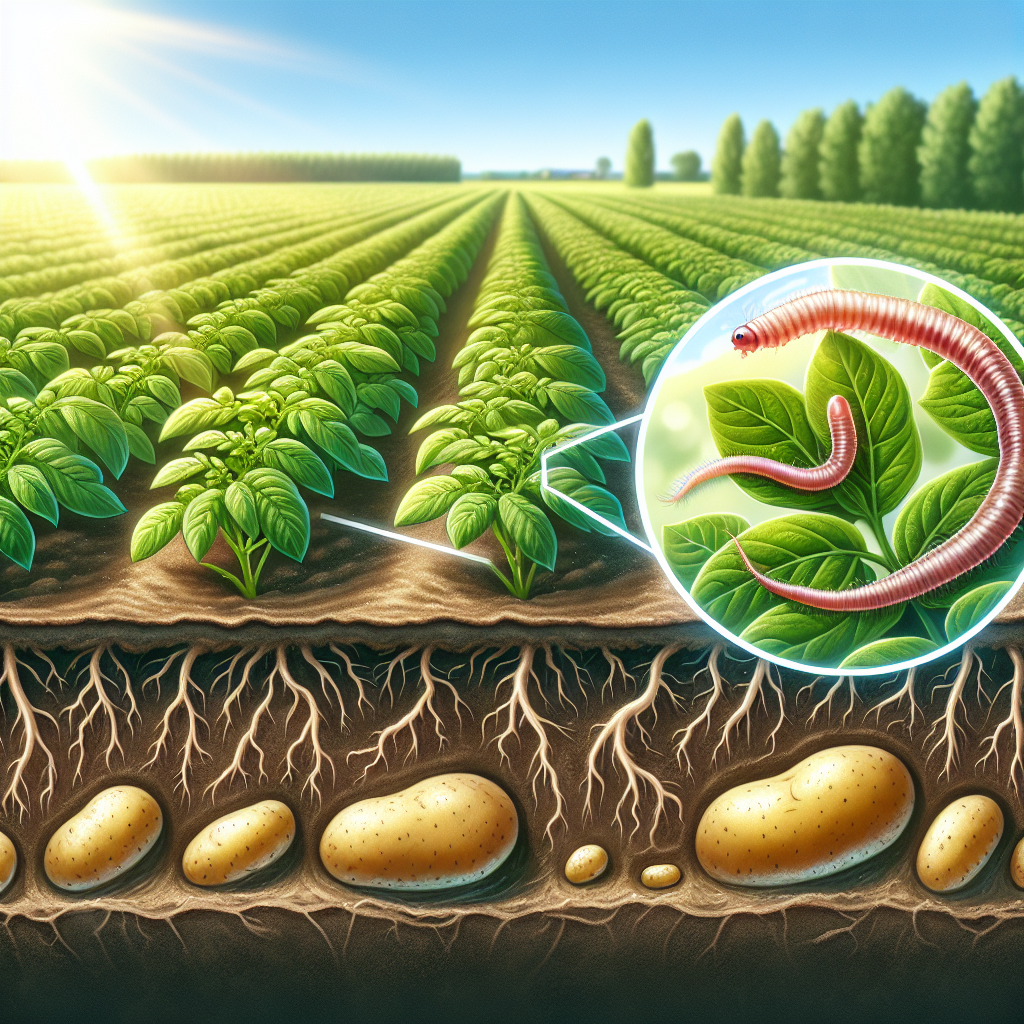Preventing Eelworm Damage in Potato Crops
Updated May 3, 2024 at 2:57 pm
Discover effective strategies for protecting your potato crops from the destructive impact of eelworms, ensuring a healthy and bountiful harvest through preventative measures and expert recommendations.

Understanding Eelworms in Your Potato Crop
As a potato grower, you may have come across tiny, thread-like pests wreaking havoc on your crop. These microscopic nematodes, commonly referred to as eelworms or more scientifically as potato cyst nematodes (PCN), can cause significant damage to your potatoes, leading to yield losses and financial headaches.
These pests primarily affect the roots, stunting growth and leading to the characteristic signs of wilting and yellowing in your plants. But before we dive into prevention, let’s briefly outline what you might be dealing with.
Overview:
- Pest Friendly:
- Signs of Infestation:
- Biological Life Cycle:
- Control Difficulty:
- Preventive Measures:
Unfortunately, eelworms find potato crops pretty hospitable, but prevention methods can make your garden less inviting.
Look out for wilting, yellowing plants, and stunted growth – classic signs of a possible eelworm problem.
Understanding eelworms’ life cycle is critical in timing your interventions correctly.
While challenging, several strategies can successfully manage eelworm populations.
Implementing crop rotation, resistant varieties, and biocontrol agents can ward off these pesky nematodes.
Identifying and Diagnosing Eelworm Infestation
If you suspect an eelworm issue, it’s essential to know precisely what to look for. The most visible symptoms include poor growth and yellowing leaves, but the true confirmation comes from examining the roots.
Small white or yellow cysts on the roots are telltale signs of eelworms. If you spot these symptoms and suspect an infestation, it’s time to take action. Keep in mind that proper plant care, like getting the most from your vegetable garden, can make your plants less susceptible to pests.
Effective Crop Rotation Strategies
One tried and true method for preventing eelworm damage is crop rotation. By not planting potatoes or related crops in the same soil for several years, you naturally reduce the nematode population.
Consider rotating with non-host crops such as cereals or legumes. These can help break the pest’s life cycle and decrease the risk of building up harmful levels in your soil.
Choosing Resistant Potato Varieties
Resistant potato varieties can be a frontline defense against eelworms. Breeders have developed specific cultivars that can fend off these pests, reducing the rate at which they multiply.
Resistant varieties might not be immune, but they can significantly minimize the damage and preserve your yield. It’s wise to research the resistance levels of different varieties and choose those suited to your particular growing conditions.
Natural Enemies and Biological Control
Introducing natural enemies of eelworms, such as predatory nematodes or fungi, can help keep the pest numbers in check. Several biocontrol products are available on the market, each with specific advantages and application methods.
Find This and More on Amazon
One example is the beneficial nematode Steinernema feltiae, which targets the eggs and juveniles of the potato cyst nematode. Such biological agents are a more eco-friendly option compared to chemical nematicides.
Chemical Control Measures
While non-chemical approaches are often preferred for their sustainability, sometimes chemical nematicides may be necessary to manage severe infestations.
Chemical treatments should be a last resort due to their environmental impact, potential harm to beneficial organisms, and the risk of the pests developing resistance. If you opt for chemicals, follow the label instructions carefully and apply them as part of an integrated pest management strategy.
Soil Solarization and Sanitation
Soil solarization is a method used in warmer climates where clear plastic is spread over moist soil to heat it up and kill nematodes. Pair this with good sanitation practices, such as cleaning equipment and removing plant debris, to prevent spreading eelworms from infested areas.
Understanding the vital steps you can take to improve soil health, like enhancing its fertility and structure, can help in the battle against these nematodes. Just like nurturing ZZ plants, taking care of the soil your potatoes grow in is essential.
Soil Health and Fertility
Maintaining soil health is paramount in preventing eelworm infestation. Healthy soil supports robust potato plants that are better able to withstand pest pressures. Enhancing soil fertility can also discourage eelworms, as they flourish in less optimal conditions.
Invest in organic matter and soil amendments to improve soil structure and nutrient content. Practices like composting and using green manures not only enrich the soil but also foster a community of beneficial microorganisms that can outcompete or deter eelworms.
Integrated Pest Management (IPM)
Integrated Pest Management (IPM) is an effective and environmentally-sensitive approach that combines different management strategies and practices to grow healthy crops and minimize the use of pesticides. It’s the agricultural equivalent of employing a combination of strategies to ensure the snake plant’s success in low light, but on a broader scale.
IPM methods could include using resistant varieties, crop rotation, biological controls, and only selectively applying pesticides when necessary. Monitoring and precise action thresholds help in determining whether and when treatments are needed, minimizing indiscriminate use of chemicals.
Sanitation Practices
On top of solarization, diligent sanitation practices are critical in your defense against eelworms. By removing plant debris from the field and ensuring that no infected tubers are left in the soil, you cut off an essential part of the nematode’s life cycle.
Disinfecting tools and equipment to prevent soil transfer between fields can further reduce the risk of spreading these pests. Sanitation is as important in the field as it is when handling ferns in low-light conditions to avoid contamination with pests and diseases.
Regulatory Compliance and Best Practices
Many agricultural regions have strict regulations regarding potato cyst nematodes due to the severe threat they pose. It’s imperative to comply with these regulations, which may include mandatory reporting, adherence to crop rotation guidelines, and using certified clean seed potatoes.
Staying informed and up-to-date with the latest best practices and science-based recommendations ensures not only that you’re on the right side of the law but also gives you the best chance to outsmart these persistent pests.
Implementing Trap Crops
Another cultural control that you might consider is the use of trap crops. These are plants that attract eelworms but do not allow them to complete their lifecycle, effectively reducing their numbers.
Such trap crops may include certain types of marigolds or solanaceous crops like tomatoes and eggplants. Planting these before your main potato crop can lure nematodes away, aligning well with strategies to create a pollinator-friendly vegetable garden, serving dual purposes in your agricultural planning.
Utilizing Green Manures
Green manures are crops grown to be plowed back into the soil to improve its fertility and physical condition. This practice can also help with eelworm control.
Some green manures, such as mustards and other brassicas, have biofumigant properties that can reduce pest populations, including eelworms, offering an alternative to traditional, synthetic soil fumigants.
Adopting No-Till Farming Practices
Transitioning to no-till or reduced-tillage farming practices can have a positive effect on soil structure and health, and it can also impact pest management.
Eelworm cysts rely on disturbance to spread and infest new soil. By reducing soil disturbance, you may be able to keep their populations more localized and manageable.
Monitoring and Regular Soil Testing
Regular soil testing is a crucial component of any pest management strategy. It helps you monitor eelworm levels and detect any issues before they become large-scale problems.
Testing soil regularly ensures you have up-to-date information on pest populations and soil health, similar to the way routine checks are integral to the well-being of philodendron goeldii in low-light conditions.
Educating and Cooperating with Neighboring Farms
In the fight against eelworms, it helps to remember that pests do not respect property lines. Educating neighboring farmers and cooperating on pest control measures can amplify your efforts.
Sharing knowledge and resources can lead to area-wide management strategies that are more effective than individual efforts, ensuring everyone’s crop yields can be optimized.
Ensuring Good Drainage
Proper drainage in your potato fields can create less favorable conditions for eelworms to thrive. Waterlogged soil can lead to weaker potato plants, which become more susceptible to pests.
Investing in adequate drainage systems can simultaneously bolster plant health and indirectly hinder eelworm development. It’s similar to knowing the importance of drainage when cultivating spider plants in low-light conditions.
Utilizing Organic Mulches
Organic mulches not only help conserve soil moisture and suppress weeds but can also act as a physical barrier to eelworm movement.
By adding a layer of organic mulch, you create a more complex environment for eelworms to navigate, potentially reducing their ability to reach your potato plants’ roots.
Evaluating New Technologies and Innovations
As agricultural science progresses, new technologies and innovations continue to emerge that could help manage eelworm problems.
Staying informed about new developments, like biotech advances or improved diagnostic tools, can position you at the forefront of eelworm management and help you adopt the most effective measures as they become available.
Working with Plant Pathologists and Extension Services
Don’t hesitate to reach out to plant pathologists and extension services for assistance. These experts can provide tailored advice, up-to-date information on control measures, and even on-site assessments if needed.
Professional guidance can be indispensable, much like seeking expert tips for successful winter vegetable gardening.
Considering Soil Health Enhancers
Soil health enhancers, such as biochar or mycorrhizal fungi, can improve soil structure and boost plant vitality, helping your crops outcompete eelworms.
Incorporating these enhancers into your soil management regimen might bring additional benefits beyond eelworm control, like increased water retention and nutrient availability for your crops.
Summary of Preventative Strategies
Managing eelworms in your potato crops involves a multifaceted approach that combines good cultural practices, biological measures, and, where necessary, chemical interventions.
Strategies like crop rotation, using resistant varieties, and implementing IPM are your best bets for minimizing eelworm damage. Remember that consistent monitoring, soil testing, and a proactive attitude towards innovation are your allies in this enduring battle against potato cyst nematodes.
Shop more on Amazon
Flowers & Plants Team
Flowers & Plants Team


